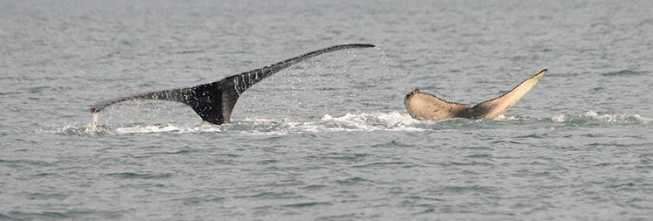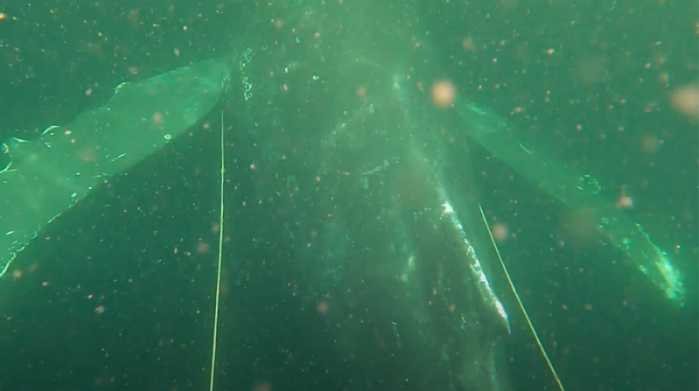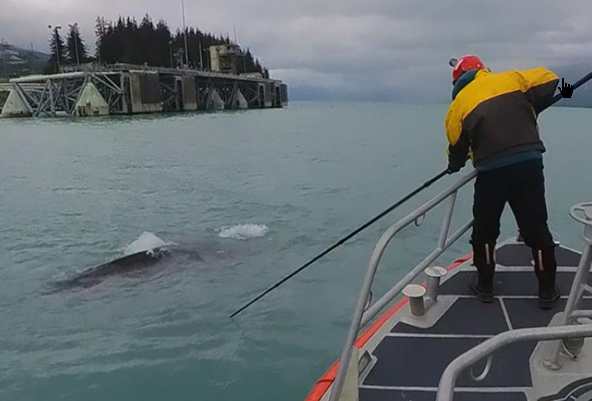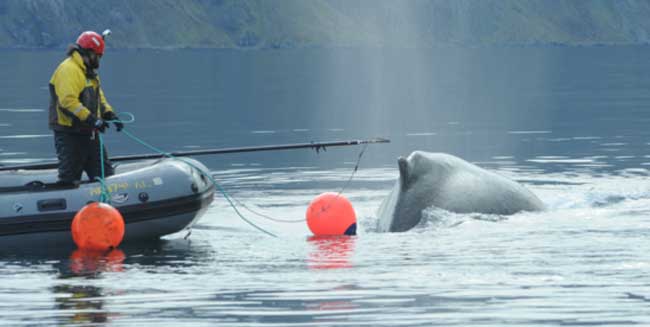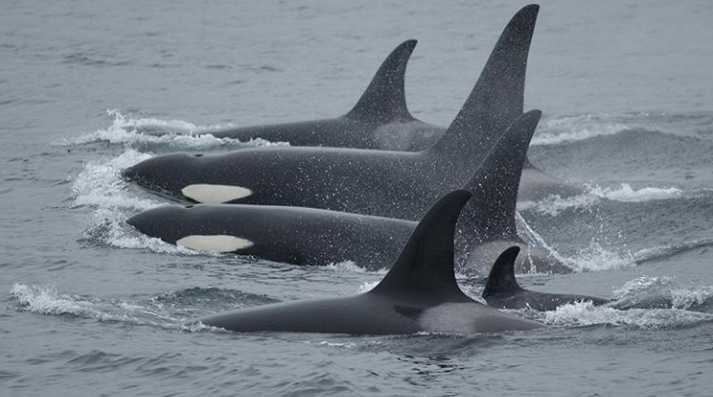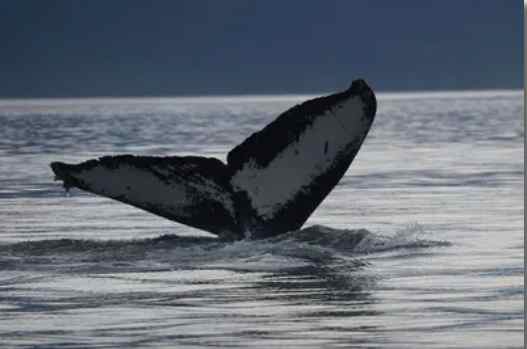The response, in a remote community, took several days and involved a broad array of partner agencies, organizations, and local trained volunteers
A humpback whale was entangled in fishing gear in Iliuliuk Bay, near the Port of Dutch Harbor, Alaska. Due to the efforts of NOAA, partners, and local trained volunteers, it was successfully cut free.
The entangled whale was first reported to NOAA Fisheries on the afternoon of April 1. The whale appeared to be anchored in place, though it was in good condition and able to breathe regularly. However, it was precariously anchored in a high vessel traffic area on the edge of the main shipping lane in Iliuliuk Bay. \
Our Alaska Marine Mammal Entanglement Response Network partners at the Alaska Department of Fish and Game responded. They were able to gather informative underwater imagery on April 2 using a GoPro pole camera. This enabled the team to better understand the configuration and severity of the entanglement and develop an action plan. The underwater video revealed that the entanglement looped through the whale’s mouth and was wrapped just forward of the whale’s flukes. The whale was essentially hog-tied. The entangling line continued from the tail down to a heavy, unknown anchoring source in approximately 100 feet of water, holding the whale in place. The video also confirmed that the whale was a subadult male. He had likely not been entangled for long. It showed strategic cutting of the entangling gear had a good chance of freeing this whale.
Two NOAA large whale entanglement response experts flew out to Unalaska to lead the disentanglement effort. They arrived in Unalaska on the morning of April 4 with additional specialized equipment to aid in the disentanglement effort. The team made an initial attempt to free the whale that afternoon. Unfortunately, some bad weather blew in, and the whale was spending most of its time at depth and out of reach. The team decided to stand down until the next morning at first light when weather forecasts indicated improvement.
The approach team regrouped on Friday morning to return to the whale in better weather conditions. Valuable safety support was provided by the U.S. Coast Guard Cutter Alex Haley and associated small boat team, Alaska state wildlife troopers, and NOAA Office of Law Enforcement.
New Tools Help Free the Whale
The team needed to gain access to the deep water lines wrapped around the animal’s tail and connecting the whale to the anchoring gear. They used a new piece of equipment: a live-streaming camera attached to a 28-foot-long pole behind a knife. The camera enabled the response team to view the cutting action in near-real time. Like a surgeon’s endoscope, this allowed the team to make strategic cuts remotely. The team was also making cuts to the rope on the outside of the body (i.e., an exoscope).
Using the exoscope, the team was able to first cut the bridle line on the left side of the body. This freed the whale’s tail somewhat to allow it to pull the line from its mouth.
When the whale did not initially respond, the team made a second approach and cut the right side bridle. This completely freed the tail from the mouth, and allowed the whale to release the wraps around its tail. This was the first documented successful use of the whale disentanglement exoscope to free an entangled whale.
“The whale swam off pretty quickly once it was no longer anchored,” said NOAA Fisheries’ Sadie Wright. “There was still a small section of line in his mouth, but we expect that the whale will shed that portion of line on its own.”
The gear that was anchoring the whale has not been recovered from the seafloor, but underwater imagery provides good documentation of the entangling lines. In the coming weeks, NOAA Fisheries and the Alaska Department of Fish & Game will share the video and photos with gear experts, including commercial fishermen and fisheries managers. This will help further identify the source of the gear. We are also examining the imagery of the whale’s flukes to determine if we can identify the individual.
“This was an emotional event for many people in this community, and their patience and support of the trained response team, I think, made all the difference in this being a successful disentanglement,” said Alaska Department of Fish & Game’s Asia Beder.
Partners Key to Disentanglement Success
The success of this disentanglement is due to help from many groups including:
- Initial reports from community members and the fishing industry in Dutch Harbor
- Local agencies who participated in all of the response efforts
- Alaska state troopers who provided safety support and a vessel
- City of Unalaska who provided updates
- Ounalashka Corporation who monitored the whale’s respiratory rate
The U.S. Coast Guard supported this response in several ways:
- Conducted regular broadcasts to mariners via VHF
- Worked with the Alaska Marine Exchange to inform mariners of the location of the entangled whale near the shipping channel with near real-time updates posted to digital charts
- Provided on-site support with a small boat team and a drone team on standby if needed
How to Assist An Entangled Whale
Entangled whales can be very unpredictable and dangerous, so please maintain a legal and safe distance of at least 100 yards from all humpback whales. Exercise extra caution and distance from an entangled whale. Unauthorized responses, while well intentioned, can result in additional injury and stress to entangled whales and increased safety risks to untrained responders. Please communicate with trained responders if you see an entangled whale.
- Call the Alaska Marine Mammal Stranding and Entanglement Network 24/7 hotline at (877) 925-7773
- Call the U.S. Coast Guard on VHF Channel 16
Information you provide may help trained, experienced, and well-equipped responders attempt to free the animal and at the same time gain information to reduce the threat.
If you’re interested in learning more about becoming a first responder, take the online training developed by NOAA Fisheries in partnership with The Nature Conservancy. It will teach you how to more effectively document and communicate with NOAA to help free entangled whales. These reports are the best way to help the animal.
[content id=”79272″]

